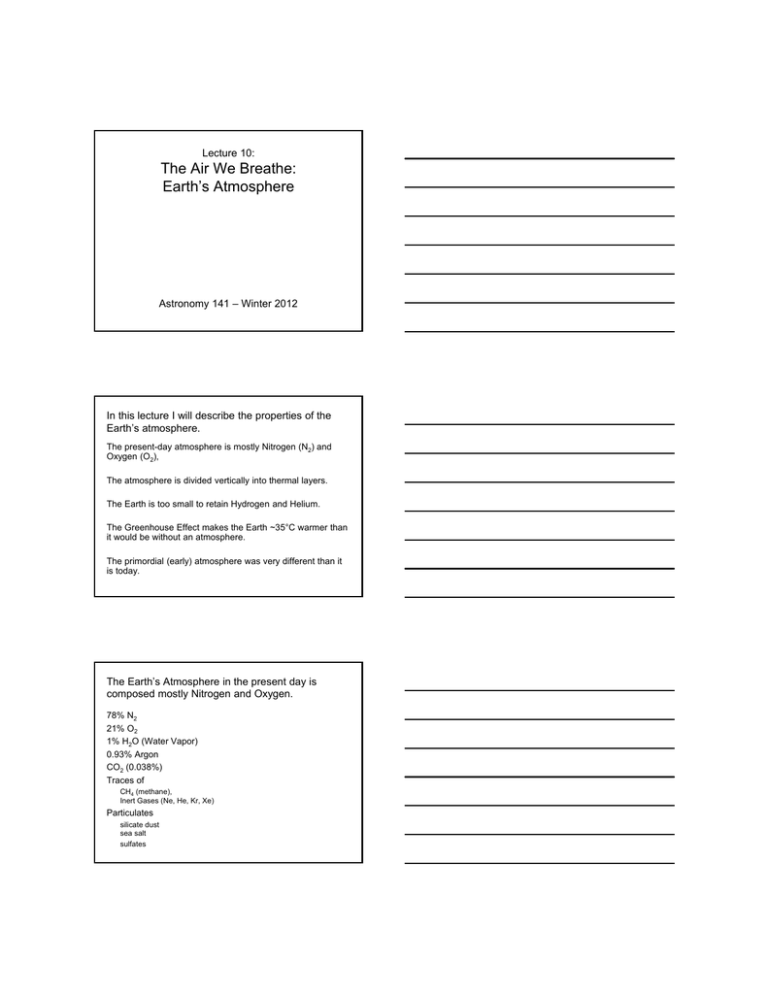The Air We Breathe: Earth`s Atmosphere
advertisement

Lecture 10: The Air We Breathe: Earth’s Atmosphere Astronomy 141 – Winter 2012 In this lecture I will describe the properties of the Earth’s atmosphere. The present-day atmosphere is mostly Nitrogen (N2) and Oxygen (O2), The atmosphere is divided vertically into thermal layers. The Earth is too small to retain Hydrogen and Helium. The Greenhouse Effect makes the Earth ~35°C warmer than it would be without an atmosphere. The primordial (early) atmosphere was very different than it is today. The Earth’s Atmosphere in the present day is composed mostly Nitrogen and Oxygen. 78% N2 21% O2 1% H2O (Water Vapor) 0.93% Argon CO2 (0.038%) Traces of CH4 (methane), Inert Gases (Ne, He, Kr, Xe) Particulates silicate dust sea salt sulfates The Earth’s atmosphere is divided vertically into five Thermal Layers Exosphere 690 km Atmospheric Pressure drops by 50% for every 5.6km you go up in altitude. At Sea Level: ~1 kg/sq-cm (14 pounds/sq-inch) Air Pressure drops exponentially by ~50% for every 5.6 km of altitude gain. 5.6 km - 50% ~11km - 25% … 56 km - 0.1% Mt. Everest: Altitude: 8850 m Pressure: ~1/3 sea-level The Earth’s gravity is too low to retain Hydrogen and Helium in its atmosphere. H & He are small and light, and so move very fast at a given atmospheric temperature. The mean atomic speeds are greater than the escape velocity from the Earth. Most of the H and He escaped long ago. Heavier molecules (N2, O2, H2O, CO2, etc.) stay trapped in the atmosphere. The ability of a planet to retain atmospheric gasses depends on its mass and temperature. Massive planets have bigger escape speeds At higher temperatures, molecules move faster At a given Temperature, though, bigger molecules move slower Massive planets can hold on to all gases better Smaller planets must be colder to hold on to gases Why is the Earth so warm? If there was no atmosphere, the Earth’s temperature would be a balance between Sunlight absorbed by the Earth (gain) Infrared photons radiated by the warm Earth (loss) Estimated Equilibrium Temperature: T=260 K But, water freezes at 273 K Why is the Earth not frozen? 51% absorbed by the ground & oceans 19% absorbed by atmosphere 30% reflected back into space Clouds 3% absorbed 20% reflected Incoming Solar Radiation Where does all the sunlight go? Atmosphere 16% absorbed 6% reflected Ground & Oceans: 51% absorbed, 4% reflected The Greenhouse Effect makes the Earth about 35°C warmer than it would be if it had no atmosphere. Visible Sunlight passes through the Earth's atmosphere and is absorbed by the ground Sunlight warms up the ground The warm ground radiates infrared photons But, the atmosphere is opaque to most IR photons: Infrared photons are absorbed by molecules of H2O, CO2, CH4 and others. This absorbed energy heats the atmosphere H2O CO2 H2O O3 After losing most of its original gasses, the early atmosphere was built by outgassing from volcanoes Volcanoes emit mostly H2O and CO2 plus H2S, SO2 and some CO but no Oxygen. Water condensed as rain to build up the oceans. What little oxygen was present was removed by mineral oxidation. The primordial atmosphere had ~1000 times more Carbon Dioxide (CO2) than it does now. Where did it all go? H2O rained out to form the oceans. CO2 dissolved in rain & ocean water Precipitated out as carbonate rocks (limestone) N2 stayed behind and became the dominant component. Today most of the CO2 is locked up in crustal rocks & dissolved in the oceans Where did the Oxygen come from? Molecular Oxygen (O2) comes from life: Photosynthesis in plants and algae produced the first O2 about 2.4 Gyr ago O2 content increased rapidly from 1% to 21% during the last 600 Myr. Ozone (O3): Forms in the stratosphere when O2 interacts with solar UV photons Blocks UV from reaching the ground. Made life on land possible. O2 & O3 are signs of life (photosynthesis) The Earth’s atmosphere is a complex, dynamic system that has evolved over time. Past Evolution: Condensation of H2O into the oceans Locking up CO2 into carbonaceous rocks Formation of O2 by photosynthesis This evolution continues into the present day: CO2 is regulated by a complex cycle Increases in O2 and CH4 from “biomass” Human activity (fuel burning & agriculture)

